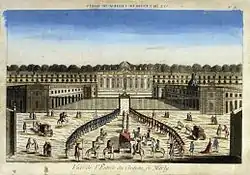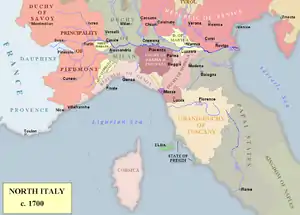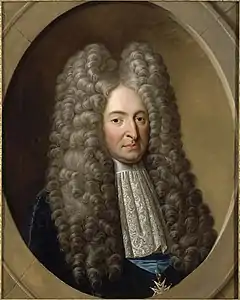Louis d'Aubusson de La Feuillade
Louis d'Aubusson de la Feuillade, duc de Roannais (30 March 1673 – 28 January 1725) was a French military officer and courtier who fought in the Nine Years War and the War of the Spanish Succession.
Louis, Vicomte d'Aubusson, Comte de La Feuillade, Baron de la Borne, Baron de Pérusse, Seigneur de Felletin, 7th duc de Roannais | |
|---|---|
 1702 Engraving of de La Feuillade | |
| Born | 30 March 1673 Marly-le-Roi, Île-de-France |
| Died | 29 January 29 January 1725 (aged 51) Marly-le-Roi, Île-de-France |
| Buried | Couvent des Théatins, Paris |
| Allegiance | |
| Years of service | 1688–1706 |
| Rank | Marshal of France |
| Unit | Cavalry |
| Battles/wars | Nine Years War 1688-1697 Philippsburg Walcourt Fleurus Landen, Charleroi War of the Spanish Succession 1701-1714 Nice Siege of Turin |
| Awards | Chevalier, Order of Saint Louis Governor of the Dauphiné 1691-1719 |
Early life

Louis d'Aubusson de la Feuillade, 7th duc de Roannais, was born on 30 March 1673, in Marly-le-Roi, near the Royal summer palace of Château de Marly. Used by Louis XIV to escape the elaborate ceremonial of the Versailles court, residence there was a sign of high favour. His father François d'Aubusson de La Feuillade (1631-1691) was also a soldier and courtier, while his paternal uncle Georges d'Aubusson de La Feuillade (1609-1697) was Bishop of Metz.
His mother, Charlotte de Gouffier, was sister and heir to Artus de Gouffier (1627-1696), the 5th duke of Roannais and a close friend of writer, mathematician and Catholic theologian Blaise Pascal. Artus entered a monastery in 1667, assigning his titles and property to François de la Feuillade, in return for 400,000 livres and marrying Charlotte.[1] Until Artus died in 1696, Louis d'Aubusson was known as 'leur-dit 7th duke of Roannais' or 'duke of La Feuillade.'
He was married twice, first in 1692 to Charlotte-Thérèse de la Vrilliere (1675-1697), then in 1701 to Marie Thérèse Chamillart (1685-1716), daughter of Michel Chamillart, Minister for War. Both marriages were childless and the title of duke became extinct on his death in 1725.
Career

In 1688, La Feuillade raised a cavalry regiment for the Nine Years War, taking part in the battles of Walcourt, Fleurus and Landen in 1693.[2] The first of the controversies that accompanied his career occurred after Landen, when it was claimed he disappeared during the battle to 'faire sa toilette,' only re-emerging at the end.[3] The accusation was serious enough for him to write a letter denying it to his first father-in-law, the Marquis de Chateauneuf. [4]
This was followed a few years later by another, equally damaging incident. After the death in 1697 of Georges de la Feuillade, Bishop of Metz, a review of the diocese financial records showed a large sum of money was missing and concluded Louis stole it while visiting his uncle. The evidence persuaded Louis XIV, who wanted to dismiss him from the army until persuaded not to do so by Louis de Pontchartrain, a friend of his father-in-law.[5]
When the Treaty of Ryswick ended the war in 1697, La Feuillade's regiment was disbanded; despite his record, he was reinstated as a brigadier in 1702 during the War of the Spanish Succession. He was promoted Marechal de camp in 1703 and posted to the French army in Italy, allegedly due to the influence of Michel Chamillart, the Minister of War, who became his father-in-law in 1701.[6]

Victor Amadeus II, Duke of Savoy had initially been an ally of France but switched sides in October 1703.[7] La Feuillade was appointed deputy to Vendôme, French commander in Italy, who gave him responsibility for occupying Villefranche and the County of Savoy, now part of modern-day France. Largely complete by the end of 1705, the primary objective in 1706 was to capture Victor Amadeus' capital of Turin; with an army of 48,000, La Feuillade initiated the siege on 12 May, although it was not completely cut off until 19 June.[8]
As was customary, Turin's defences were divided into the outer 'City,' containing the residential and commercial areas, and the 'Citadel' at its core. La Feuillade and Vendôme proposed digging trenches around the City at a distance of 300-400 metres, then blasting the Citadel into submission, an approach known as the 'Coehoorn method', after the Dutch engineer, Menno van Coehoorn. However, Victor Amadeus had significantly improved the Citadel's defences since 1696, using a design provided by Vauban, the French military engineer, and much of it was now underground. Vauban therefore recommended they take the City first, allowing their artillery to target the base of the Citadel's walls.[9] This advice was ignored and Vauban allegedly offered to have his throat cut if Turin were captured using this approach.[10]

The French position in Italy changed with the disastrous defeat at Ramillies on 23 May. As a result, Vendôme was sent to Northern France in July and Philippe, Duke of Orléans assumed command in Italy, advised by Marshal Ferdinand de Marsin. Orléans joined La Feuillade at Turin and their combined forces assaulted the city three times between 27 August and 3 September, each one repulsed with heavy loss. The Siege of Turin ended in September when a relief force under Prince Eugene broke the French siege lines near Collegno.[11]
With France's northern border under pressure after Ramillies, Louis XIV needed to end the war in Italy and in March 1707, he agreed the Convention of Milan with Emperor Joseph I. To the fury of Joseph's allies, the French withdrew their remaining garrisons, ceding control of Milan and Mantua to Austria but in return were given free passage to France, allowing them to be redeployed in other theatres.[12]
This ended La Feuillade's military career, a combination of defeat and the accusation that he left the siege in a fruitless attempt to capture Victor Amadeus, although he was given the honorary title of Marshal of France in 1724. During the 1715-1723 Regency or Régence that succeeded Louis XIV, he was offered the post of Ambassador to Rome but turned it down; his position as Governor of La Dauphiné was transferred to Louis, later Duke of Orléans in 1719.[13] He was buried in the Couvent des Théatins in Paris, which was demolished in 1825. [14] The title 'Duke of Roannais' became extinct on his death but his subsidiary titles and lands passed to Jacques d'Aubusson, Baron Miremont.[15]
References
- Anselme, Augustin Dechauffé, Du Forny (1750). Histoire de la Maison Royale de France, et des grands officiers de la Couronne Volume V. Compagnie des Libraires. p. 349.
- "La Feuillade, Louis d'Aubusson". tombes-sepultures.com. Retrieved 20 December 2018.
- Saint Simon, Louis de Rouvray, Boislisle, Arthur Andre (ed) (1879). Memoires de Saint-Simon. Hatchette et Cie, Paris. p. 253. Retrieved 21 December 2018.CS1 maint: extra text: authors list (link)
- Letter to M de Chateauneuf dated August 1693, National Archive reference G552
- Chapman, Sara (2004). Private Ambition and Political Alliances in Louis XIV's Government. University of Rochester Press. p. 29. ISBN 1-58046-153-0.
- Lynn, John (1999). The Wars of Louis XIV 1667-1714. Longman. p. 309. ISBN 0582056292.
- Falkner, James (2015). The War of the Spanish Succession 1701-1714 (Kindle ed.). 1302: Pen and Sword. ISBN 9781473872905.CS1 maint: location (link)
- Symcox, Geoffrey (1983). Victor Amadeus II: Absolutism in the Savoyard State, 1675-1730. University of California Press. p. 150. ISBN 0520049748.
- Duffy, Christopher (1985). The Fortress in the Age of Vauban and Frederick the Great 1660-1789 (2017 ed.). Routledge. pp. 50–51. ISBN 1138924644.
- Lynn p.309
- Lynn p.310
- Sundstrom, Roy A (1992). Sidney Godolphin: Servant of the State. EDS Publications Ltd. p. 196. ISBN 0874134382.
- Saint Simon, Louis de Rouvray, Boislisle, Arthur Andre (ed) (1879). Memoires de Saint-Simon. Hatchette et Cie, Paris. p. 226. Retrieved 20 December 2018.CS1 maint: extra text: authors list (link)
- "Couvent des Théatins". Weekisto. Retrieved 20 December 2018.
- Moreri, Louis (1749). Le grand dictionnaire historique ou Le melange curieux de l'Histoire sacrée; Volume I. Libraires Associes, Paris. p. 20.
Sources
- Anselme, Augustin Dechauffé & Du Forny; Histoire de la Maison Royale de France, et des grands officiers de la Couronne, Volume V; (Compagnie des Libraires, 1750);
- Duffy, Christopher; The Fortress in the Age of Vauban and Frederick the Great 1660-1789; (Routledge, 2017 ed)
- Chapman, Sara (2004). Private Ambition and Political Alliances in Louis XIV's Government; (University of Rochester Press, 2004);
- Falkner, James; The War of the Spanish Succession 1701-1714; (Pen and Sword, 2015);
- Lynn, John; The Wars of Louis XIV 1667-1714; (Longman, 1999);
- * Moreri, Louis; Le grand dictionnaire historique ou Le melange curieux de l'Histoire sacrée; Volume I; (Libraires Associes, 1749);
- Saint Simon, Louis de Rouvray (author), Boislisle, Arthur Andre (ed); Memoires de Saint-Simon (Hatchette et Cie, 1879);
- Sundstrom, Roy A; Sidney Godolphin: Servant of the State; (EDS Publications Ltd, 1992);
- Symcox, Geoffrey; Victor Amadeus II: Absolutism in the Savoyard State, 1675-1730; (University of California Press, 1983);
External links
- "Couvent des Théatins". Weekisto. Retrieved 20 December 2018.;
- "La Feuillade, Louis d'Aubusson". tombes-sepultures.com. Retrieved 20 December 2018.
| French nobility | ||
|---|---|---|
| Preceded by François d'Aubusson de La Feuillade |
Duke of Roannais 1691–1725 |
Extinct |
| Preceded by François d'Aubusson de La Feuillade |
Comte de la Feuillade 1691–1725 |
Succeeded by Jacques d'Aubusson |
| Military offices | ||
|---|---|---|
| Preceded by François d'Aubusson de La Feuillade |
Governor of La Dauphiné 1691–1719 |
Succeeded by Louis, later Duke of Orléans |